Shy red wolves come into view in renowned muralist’s new work in NC wildlife refuge
The 19 or so red wolves that move like a subtle breeze through about 80 square miles of wildlands in Eastern North Carolina are so stealthy, most people don’t even know they’re there.
That’s part of their problem.
“We have school groups come here and we ask how many of them have ever heard of a red wolf,” said Kat Ramos, who coordinates red wolf education and outreach for the North Carolina Wildlife Federation. Typically, Ramos said, these are students who live in Tyrrell County — in the heart of the only place on earth where endangered red wolves exist in the wild — but only one or two will raise their hands.
“I tell them, this is your animal. This is our animal.”
So Ramos was elated to see a project get underway this month that will transform the once unremarkable building where she works into an oversized art installation that will celebrate the red wolf and draw attention to efforts to restore the species to the ecosystem.
Renowned muralist Matt Willey, who lives in Asheville, came up with the design for two sides of the Red Wolf Center in the Pocosin Lakes National Wildlife Refuge on N.C. Highway 94 about a mile outside Columbia.
To get the process started, he projected the design onto the building on a dark night at the beginning of April to sketch out the placement. Since then, teams of artists have been working alongside him to add color and depth to the portraits of two adult red wolves and two pups, along with one of Willey’s signature creatures, a bee.
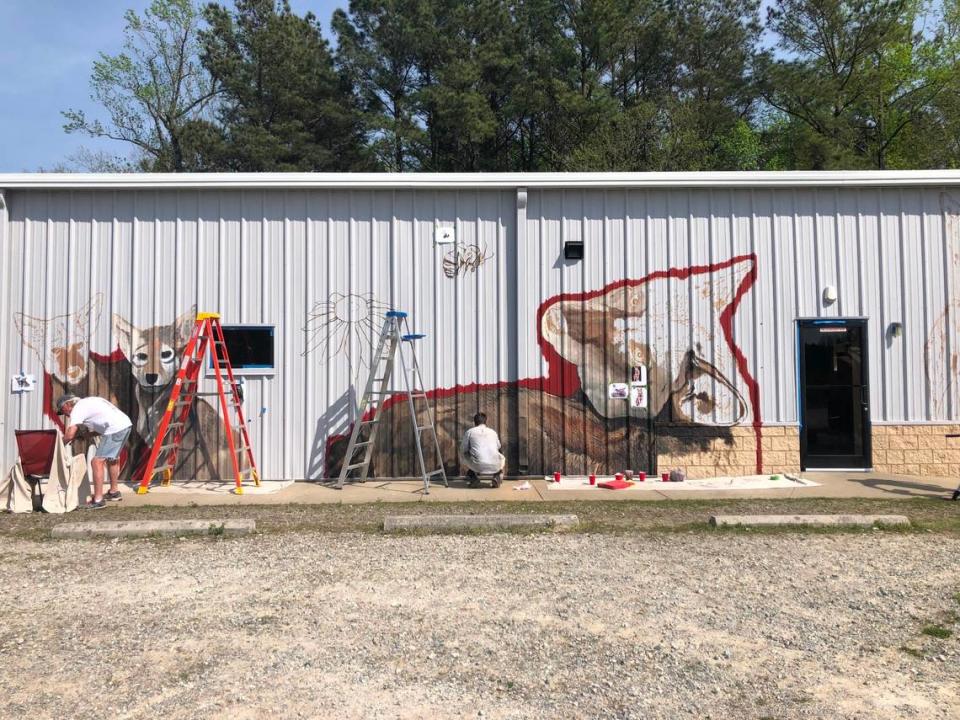
Willey: The bee painter
Willey is best known for the mission he launched in 2015 to hand-paint 50,000 honey bees, one for each member of an average-sized healthy hive, in murals around the world. He’s up to 10,000 so far in 38 murals, including more than a dozen in North Carolina at such places as the Museum of Natural Sciences in Raleigh, the Carrboro Fire Station, Burt’s Bees Global Headquarters in Durham and a commercial building in downtown Wendell.
Setting down his brush to mix more paint last week, Willey recounted the story of the founding of the bee mural project, which he calls The Good of the Hive. He was in his studio in his native New York in 2008 when a bee flew in and landed on the carpet. Intrigued, he got down on the floor and watched her walk around, not realizing she was likely in need of food or water. He took her outside but she soon died.
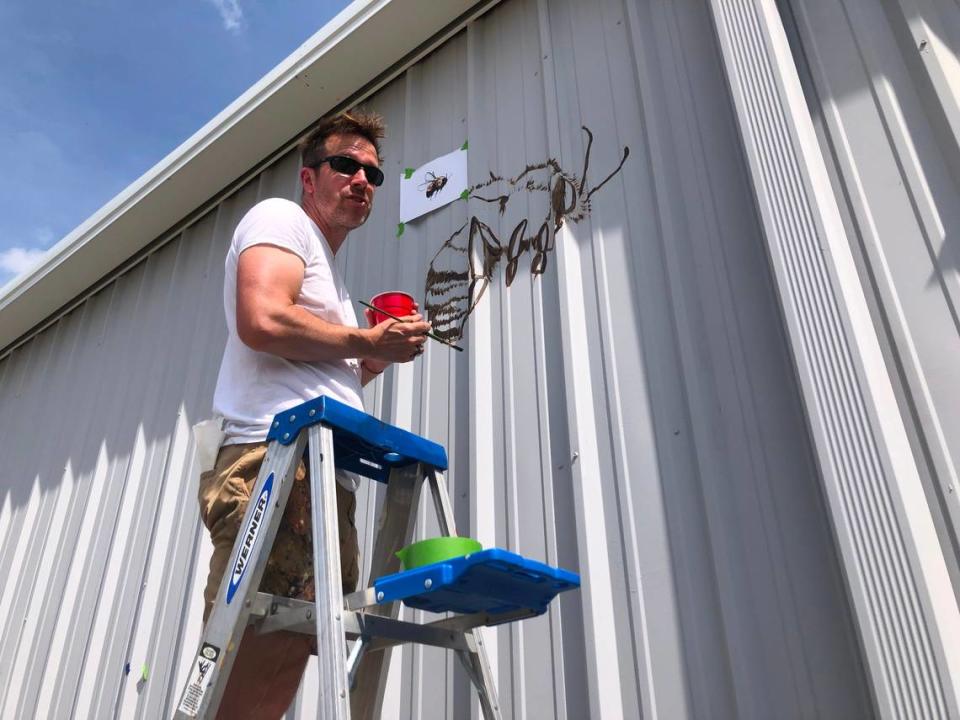
In the two and half hours he had with the bee, Willey said, “I made a connection with her.”
He began to research bees and learned about the critical role they play as pollinators in making sure humans have food to eat. He learned about the threats they face, which the USDA categorizes as “parasites and pests, pathogens, poor nutrition, and sub-lethal exposure to pesticides.”
In his research, Willey said, he came across the notion of “altruistic self-removal from the hive,” when an ailing bee exits to prevent spreading disease through the colony, “for the good of the hive.”
Willey said he looked around him and suddenly saw the whole world as a hive, with people scrambling about in subways and neighborhoods, in cities and across the planet, yet not doing much for the good of those around them.
Until then, most of his mural work had been jobs such at sports arenas, businesses or the bedrooms of clients’ children. But he said he couldn’t stop thinking about bees.
“I love anything that is that tiny and that powerful,” he said.
His first bee mural was at the Harold P. Curtis Honey Co. in LaBelle, Fla., whose proprietor first had to get a local ordinance changed to even allow such a big piece of public art.
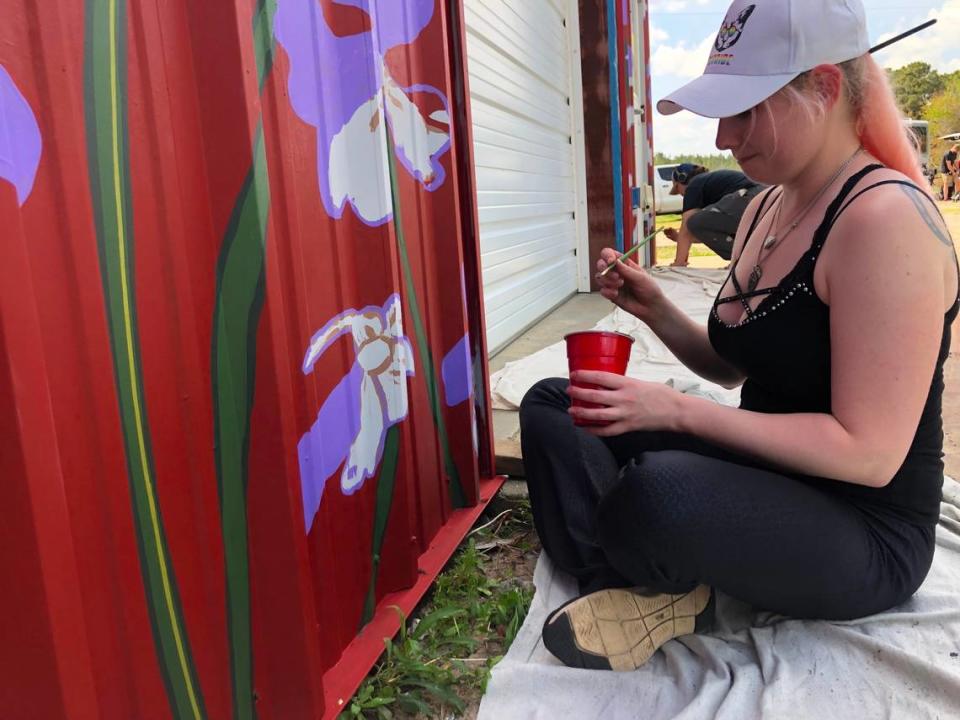
Saving the ‘underdog’ red wolf
Willey plans to spend 21 years total on the 50,000 bee paintings, signifying the time from human birth to adulthood, and he was about seven years into it when he met Loti Woods and Dale Weiler last year.
The couple had founded Weiler Woods for Wildlife, also based near Asheville, to put their mutual interests in wildlife to use in conservation work. Woods, retired from the insurance industry, and Weiler, a sculptor, recruited Willey to paint a mural featuring red wolves, one of what Woods calls “underdog species.” The couple has raised money to help pay for the mural.
Red wolves once roamed the area from Pennsylvania to Florida and west all the way to Texas, but were declared extinct in the wild in the 1980s because of human persecution and habitat loss, according to the U.S. Fish & Wildlife Service. Known animals were trapped and placed in captivity to preserve the species.
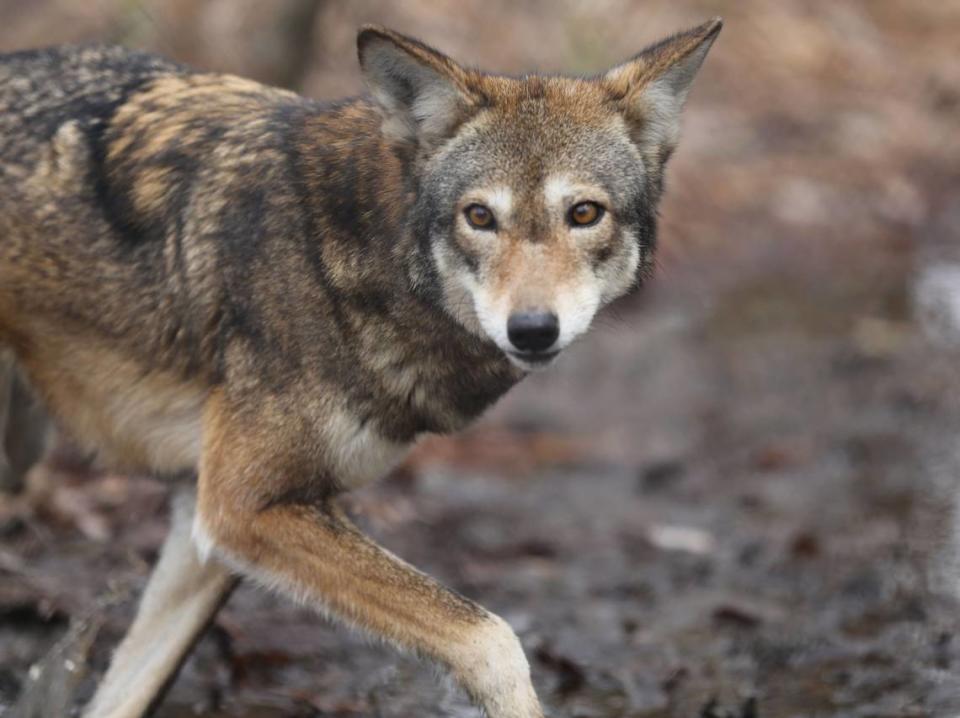
In 1987, Fish & Wildlife researchers reintroduced the animals to Eastern North Carolina, and in 2012 there were at least 120 red wolves in the wild in the state, in addition to the 241 animals in 45 captive breeding facilities across the country.
The reintroduction program met with some resistance. Though red wolves are protected under the Endangered Species Act, wolves placed or born in the wild through the recovery program have been shot by hunters or property owners, crowded out by habitat loss and killed by vehicles.
After peaking at 120 to 130 wild red wolves in the mid 2010s, the population is down to 14 animals that have been collared and as many as five more thought to be living in what biologists call North Carolina’s Albemarle Peninsula, which includes Pocosin Lakes, Alligator River and other wildlife refuges.
The mural at the Red Wolf Center is Willey’s first foray into paintings that incorporate the connections between pollinators, other plants and animals, and it’s the first time he has taken on a project that, once the brushes came out, has to be completed in two weeks.
“I don’t do deadlines,” said Willey, whose usual turnaround is six to 10 weeks.
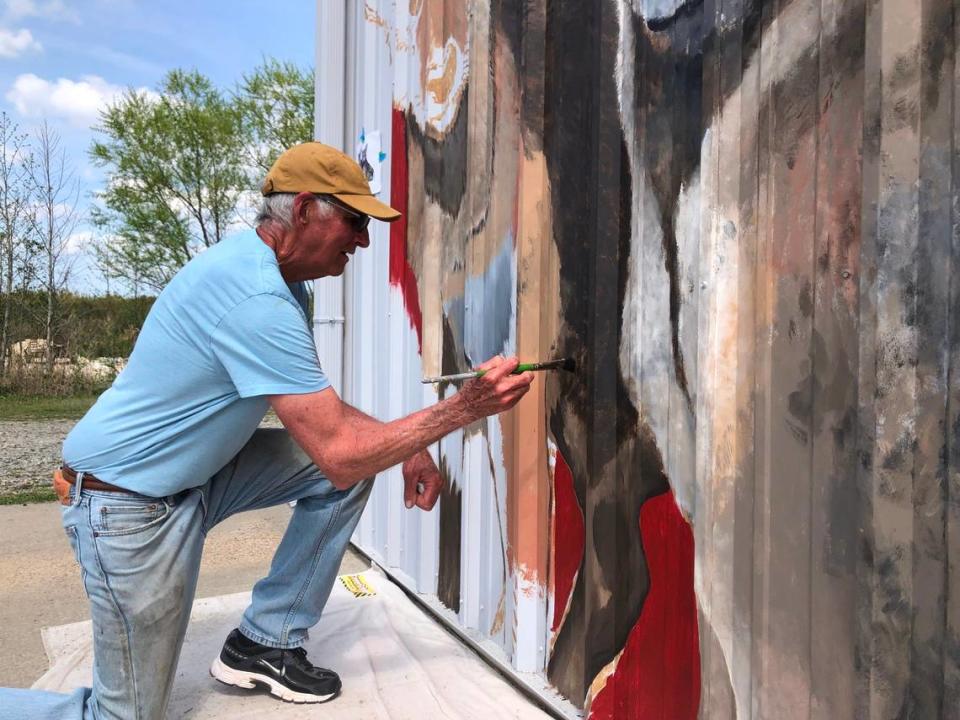
Drawing attention to NC’s Red Wolf Center
Complicating the process is the fact that the Red Wolf Center is built of corrugated steel, which can distort the images Willey wants to create.
In this mural, Willey is adding a rusty patched bumblebee, native to the local wildlands, instead of a honey bee. It will buzz above the wolves’ heads.
To get the work done in time, organizers invited in other artists, who have volunteered and spent hours dabbing paint to make enlarged versions of schematics printed on 8-by-10-inch pages taped to the building. Behind the crew, traffic barrels down the highway, taking drivers to the Alligator River, Lake Mattamuskeet or the ferry from Swan Quarter across the Pamlico Sound to Ocracoke.
Until now, most drivers probably never noticed the Red Wolf Center, or thought it was a big maintenance shed.
When the mural is finished on April 15, the big, golden-eyed wolves against a barn-red background should grab the attention of passersby. Woods hopes they’ll be inspired to find out about the Red Wolf Center, come by for an educational program or to observe the two red wolf brothers on exhibit in an enclosure behind the center (also visible on the N.C. Wildlife Federation’s web cams) and possibly even get involved in conservation work.
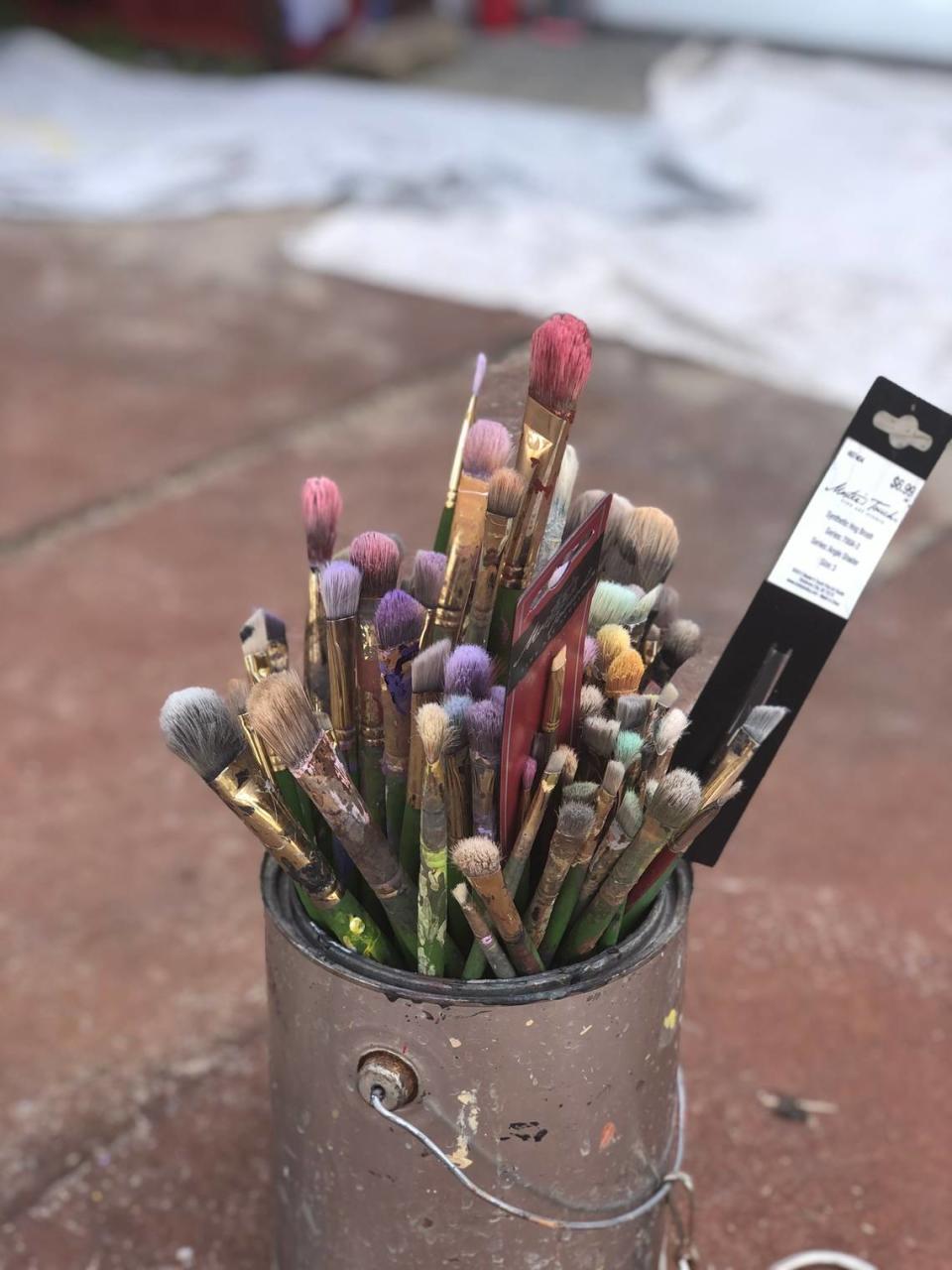
Hollie Hewitt said she knew about red wolves growing up in Columbia and even wrote a paper on them in high school. Now, she’s helping paint the mural and hoping it will inspire others to learn that there is no record of a red wolf ever attacking a human; they have a role in helping reduce the white-tailed deer population, in particular animals that are sick or frail; they eat raccoons, rabbits, nutria and other rodents.
“People here still worry about their dogs and cats and kids being attacked by red wolves,” Hewitt said, adding another shade of purple to a field of phlox on the mural.
“It’s a misconception, but most people don’t want to get past that. They need to be educated. I hope this will help with that.”

